
Joe Eichler Timeline 4: Triumphs, Tragedy in the ‘60s
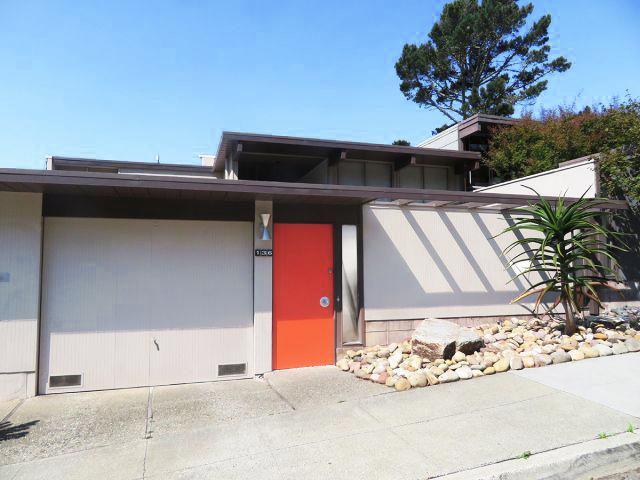 |
Joe Eichler's interest in bettering society, and in accomplishing great things as a developer, motivated him more than making money, his son Ned has said.
He could have done well sticking with single-family homes, but was driven to build redevelopment projects in urban areas. In a way, his social conscience led to the downfall of Eichler Homes, as high-rise and low-rise developments in the city sapped cash.
Just as Joe and his wife were moving into a swanky penthouse, whose interior he had Wright protégé Aaron Green design, his firm verged on collapse.
This is our fourth installment of the Eichler Timeline. Read parts one, two and three.
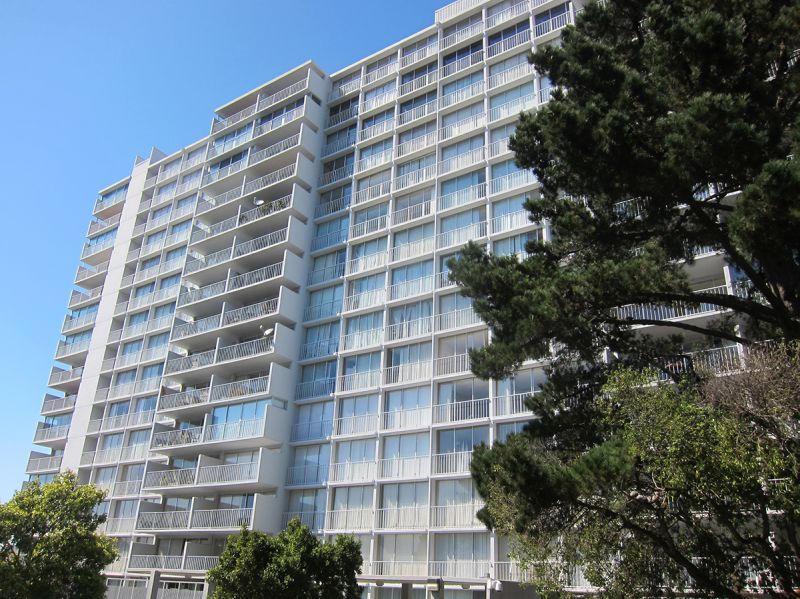 |
1961. Eichler builds two townhouse communities in Santa Clara, Pomeroy West and Pomeroy Green. Increasing scarcity of land causes Eichler to focus on what he calls “a more intensive use of land.” One was a housing cooperative, another a condominium, new concepts in this area.
1961. Greenmeadow Apartments. This collection of single-story homes with shared walls is Eichler’s first venture into town-house-like rentals, one that he repeats several times in Palo Alto and nearby communities. They adjoin the Greenmeadow subdivision and today are the Meadowcreek condos. Throughout his career Eichler has his architects design apartments to be built near his single-home subdivisions, including at Lucas Valley in Marin. Few are built.
1961. Architect Aaron Green designs arrow-shaped and semi-circular homes for San Mateo Highlands. These would have been unique in Eichler’s oeuvre. Green is a protégé of Frank Lloyd Wright. Although they are not built in San Mateo, one of Green’s models, the Sunspot, is later built as a custom home at Stanford.
1961. Eichler and Jones & Emmons develop an unusual plan for homes sunken into earthen berms, as part of Art & Architecture magazine’s Case Study project. Berms would provide insulation and reduce noise, and the community would have much common open space. Proposed for the city of Chatsworth, it is rejected by the city as too experimental.
1961. Groundbreaking for Eicher’s first-built venture in San Francisco, the Laguna Heights project, one high-rise residence of reinforced concrete, and a series of two-story condos and apartments, in San Francisco’s Western Addition. This is a Redevelopment project and requires Eichler to take part in a competition. Among Joe’s other San Francisco projects is Central Towers in the heart of the Tenderloin.
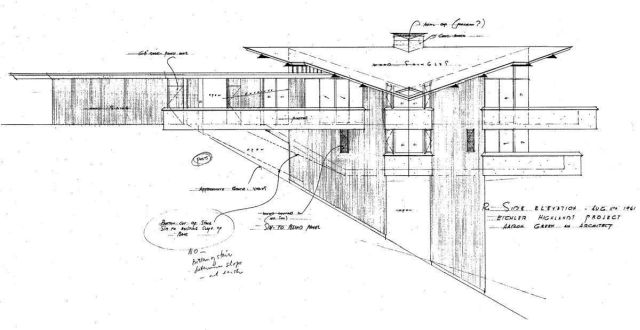 |
1961. Eichler builds for the first time in Southern California, beginning in the city of Orange with three subdivisions. From 1962 to 1964 Eichler Homes builds Granada Hills in Los Angeles’ San Fernando Valley, and in 1963 starts building a 100-home subdivision in Thousand Oaks in Ventura County. Several unrealized projects in the Southland include Redondo Beach Apartments from 1962.
1961. Eichler Homes goes public. Much of the stock is sold to family and employees, including architect A. Quincy Jones and longtime carpenter Aaron Wheeler, but to some outsiders as well.
1961-1965. Eichler develops two side-by-side projects in Visitacion Valley, a working class neighborhood at San Francisco’s southern edge. They are the high-rise Geneva Towers and low-rise Geneva Terraces. Although meant to house people of mixed income, they become low income housing. Geneva Towers grows dilapidated in later years and is imploded in 1998. The Terraces, arrayed around parkland designed by Royston, Hanamoto, Mayes & Beck, remain an attractive place.
1962. Eichler builds a community of attached single-family row homes in San Francisco’s Diamond Heights, a redevelopment project. They are two-story and many have atriums.
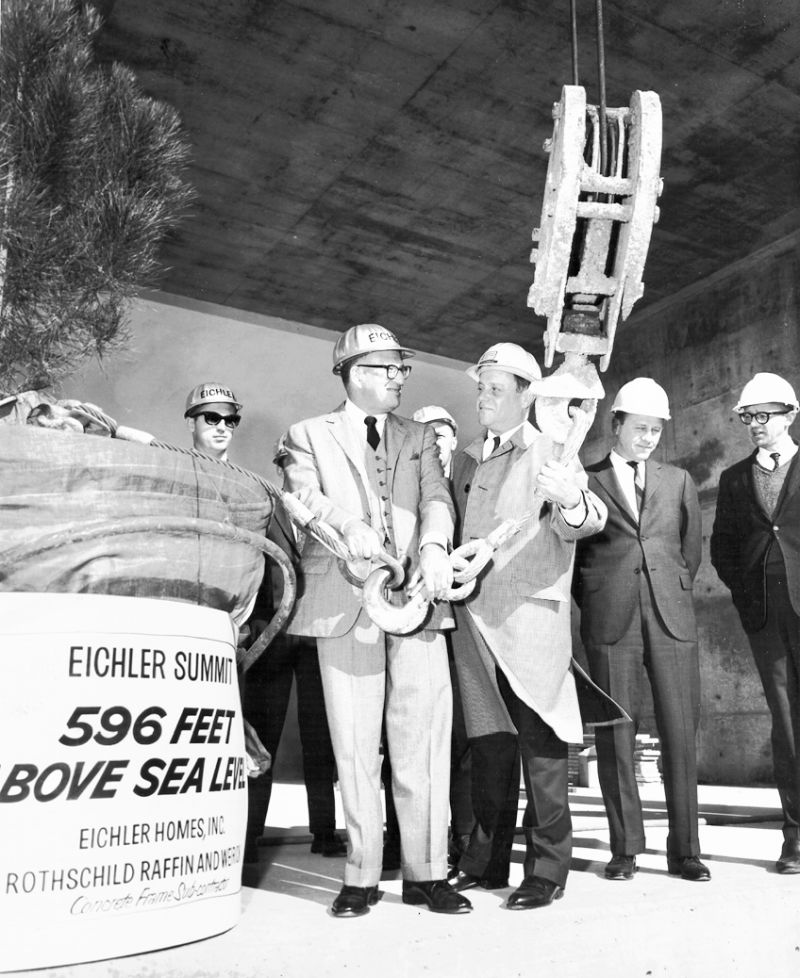 |
1962. Eichler builds homes in New York, in Ramapo, a small town north of Manhattan. Ned urges his dad to drop the idea of building 3,000 miles from home. Sales lag and only three homes are built and much money lost. The homes remain largely intact today. That same year Eichler proposes a 126-home subdivision on Long Island that is rejected by planners.
1963. The gallery model is introduced in a design by Claude Oakland. Unlike the atrium, which is open to the sky, the gallery is roofed, but is also an undefined, often sky-lighted interior space often between entry and main living areas. Many variants from large to small will be produced in coming years.
1964. Eichler completes building Jordan Quad on the Stanford campus, the only academic building he ever builds. Architect is Claude Oakland.
1964. Eichler’s grandest high-rise tower, the Summit, opens atop Russian Hill. Lead designer of this reinforced concrete luxury residence is Tibor Fecskés. Joe and Lillian move into the penthouse. This is just one of several projects in San Francisco, as Eichler concludes that many buyers would prefer to live in cities.
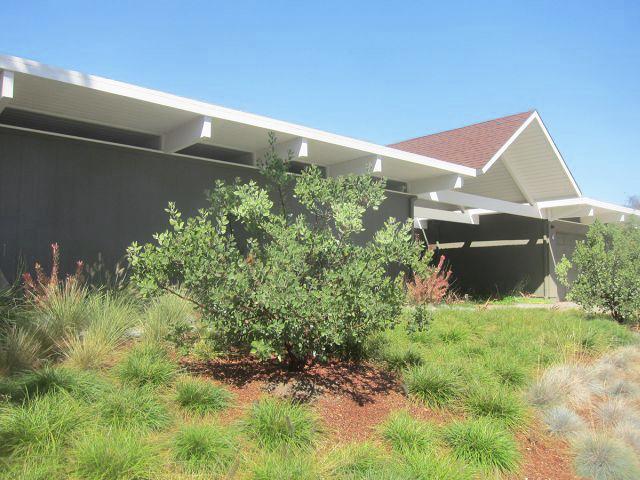 |
1964. Eichler builds his only waterfront community, Harbor Point. The development on Marin’s Strawberry Point peninsula, includes large homes, some of which are two story and step down the hillside towards the shore.
Mid-1960s. Plans for other high-rise and senior residential projects are never built. Eichler experiments with a new housing type for Eichler Homes, a retirement community in San Mateo. He also has architects Jones & Emmons and Claude Oakland develop plans or feasibility studies for high-rise towers that would have been his first outside of San Francisco (in Palo Alto, San Jose, and San Mateo).
1965. Eichler Homes ends in bankruptcy. Cash flow problems tied to his ambitious urban schemes force Eichler first to sell his interest in Eichler Homes, while remaining an officer, and then force Eichler Homes into bankruptcy. Foremen, carpenters, marketing, accounting, and other office workers, many of whom have worked for Eichler many years, lose their jobs. Joe is hospitalized after a heart attack.
- ‹ previous
- 359 of 677
- next ›



